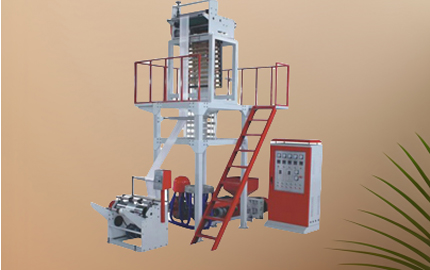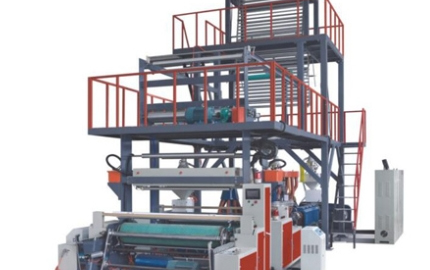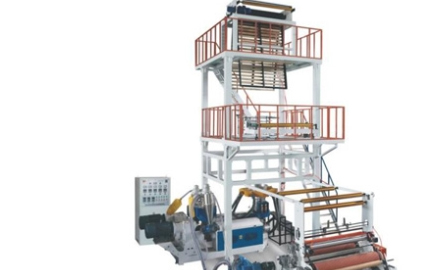Blown film extrusion is a dominant manufacturing process used to create a wide variety of plastic film products, from simple shopping bags to complex multi-layer barrier films used in food packaging. This versatile technique involves inflating a molten thermoplastic tube into a bubble, which is then cooled and collapsed to form a thin, continuous film. This article will explore the fundamentals, equipment, process steps, and applications of this critical industrial method.
The core principle involves melting plastic resin and forming it into a tube. This tube is then inflated with air, stretching the plastic in both the machine direction (MD) and transverse direction (TD)—a process known as biaxial orientation. This stretching significantly enhances the film's strength, clarity, and tear resistance.
Key characteristics of the final film are defined by:
Gauge: The thickness of the film.
Layflat Width: The width of the flattened tube.
Bubble Diameter: The size of the inflated tube before collapsing.
A standard blown film extrusion line consists of several key pieces of equipment:
Extruder: The heart of the system. It is a barrel containing a rotating screw. The resin pellets are fed into the hopper and conveyed by the screw. Through the application of heat from external heaters and shear friction from the screw, the plastic is melted into a uniform, viscous fluid.
Die: The molten plastic is forced through a circular die, forming a continuous hollow tube. The die is crucial for distributing the polymer evenly around its circumference.
Air Ring: Mounted at the top of the die, the air ring blows cool air onto the outside surface of the hot bubble, causing it to solidify.
Cooling System: Beyond the air ring, an Internal Bubble Cooling (IBC) system is often used. It circulates cool air inside the bubble to control its temperature precisely, allowing for higher production rates and more consistent film properties.
Nip Rolls and Collapsing Frame: Located high above the die, these rolls pinch the bubble flat, sealing the air inside and pulling the film continuously through the line. This pulling action helps determine the stretch in the machine direction.
Haul-Off (Take-Up) Unit: This system pulls the flattened film from the nip rolls and controls the tension and speed of the line.
Winder: This unit winds the finished, flattened film into large rolls (called logs) for storage, shipping, or further conversion.
The process can be broken down into a continuous cycle:
1. Feeding & Melting: Plastic resin pellets, often mixed with additives like colorants or slip agents, are fed into the extruder's hopper. The rotating screw pushes them forward through different heating zones, where they are gradually melted and homogenized.
2. Extrusion: The molten plastic is pumped under high pressure through the circular die, emerging as a thick-walled tube.
3. Inflation & Stretching: As the tube exits the die, compressed air is introduced through the center of the die, inflating the tube like a balloon. This creates the "bubble" and stretches the film radially (transverse direction). Simultaneously, the haul-off unit pulls the bubble upward, stretching it longitudinally (machine direction).
4. Cooling: The air ring immediately quenches the outside of the bubble. The IBC system manages the internal temperature. Rapid and controlled cooling is essential for achieving the desired crystal structure and optical properties (clarity) of the film.
5. Collapsing & Hauling-Off: The bubble is guided upward by a series of frames until it passes through the nip rolls, which collapse it into a flat, double-layered sheet.
6. Winding: The flattened film is then wound onto a core by the winder, creating a uniform roll of finished product.
RK-SJA50/800 Single Layer Blown Film Machine is 38 chrome molybdenum aluminum alloy by high-quality nitriding treatment, the screw is also made of cemented carbide coating, high hardness, wear and corrosion resistance.

RK-ABA 3 Layer Film Blowing Machine is characterized by high efficiency, stability, excellent wear resistance and cooling effect, and is the preferred equipment in the field of packaging material production.

RK-3JS50/55/65 ABC Film Extrusion Machine is an equipment for the efficient production of three-layer plastic films. It can produce high-quality, multi-functional films and is widely used in many industries.

The versatility of blown film makes it applicable in numerous sectors:
Packaging: The largest application area. Includes grocery bags, shrink film, stretch wrap, food packaging (fresh produce, snacks, frozen foods), and barrier packaging for medical products.
Agriculture: Greenhouse films, mulch film, and silage bags.
Construction: Vapor barriers, protective sheets, and pond liners.
Consumer Goods: Disposable aprons, diaper backing sheets, and apparel packaging.
Biaxial Orientation: The inflation process stretches the film in two directions, yielding a stronger, more tear-resistant film with better optical properties than cast film.
Gauge Control: Modern systems offer excellent control over film thickness.
Tubular Product: The process naturally creates a seamless tube, ideal for making bags without side seals.
Flexibility: A single line can produce a wide range of widths and diameters by simply changing the bubble size and haul-off speed.
Cost-Effectiveness: For many applications, it is a highly efficient and economical production method.
The manufacturing process of blown film extrusion involves melting plastic resin, forming it into a continuous tube through a circular die, inflating it into a bubble with air to stretch it thin, then cooling and collapsing it to create a flat film roll.
Q1: What materials are most commonly used?
A: Polyethylenes (LDPE, LLDPE, HDPE) are the most common. Polypropylene (PP) and multi-layer structures incorporating nylon (PA) or EVOH for barrier properties are also widely used.
Q2: How does blown film differ from cast film?
A: Blown film is extruded vertically and inflated, giving it balanced properties. Cast film is extruded onto a chill roll, resulting in higher clarity but less balanced tear strength.
Q3: How is film thickness controlled?
A: Thickness is controlled by adjusting the extruder output, haul-off speed (MD stretch), and air pressure inside the bubble (TD stretch). Automated gauge control systems provide real-time adjustment.
Q4: What are common production challenges?
A: Key challenges include maintaining consistent gauge, ensuring bubble stability, managing cooling efficiency, and handling variations in raw material.
Q5: Is blown film recyclable?
A: Films made from a single polymer type (like PE) are readily recyclable. Multi-layer films are more challenging but advancements in compatible materials and recycling technologies are improving sustainability.